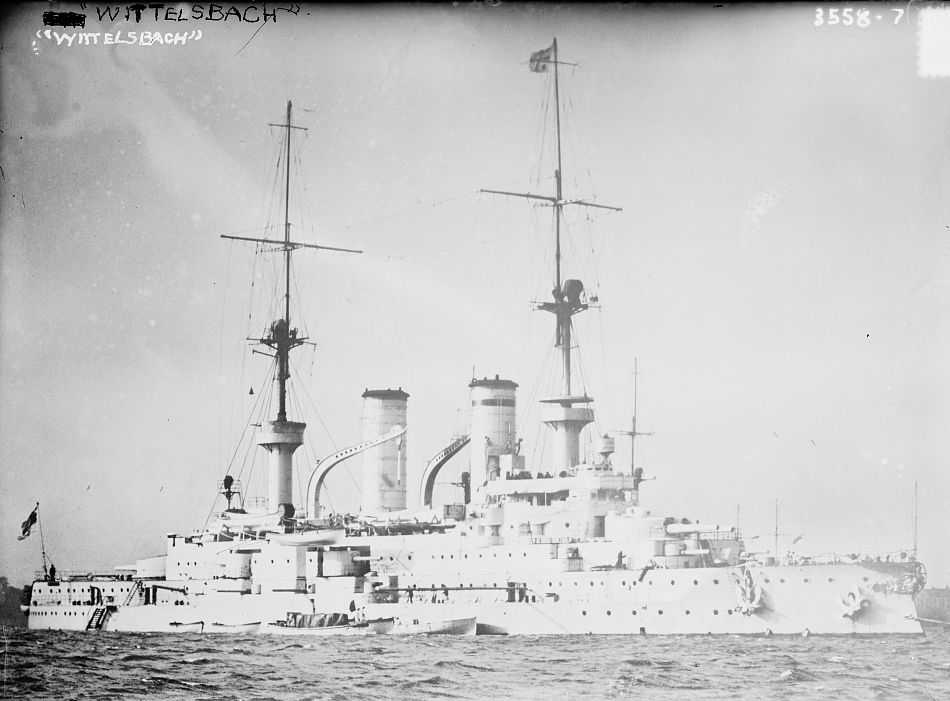
This was the first German heavy gun to use brass cartridge cases and was used on pre-dreadnoughts and "First Rate Cruisers" of the 1890s. After the ships were decommissioned, eight guns in four turrets from the Kaiser Friedrich III class were emplaced on the mole at Libau. Four more guns were used in Battery Hamburg on Nordeney and four guns were in Battery SI on Sylt. A turret from Prinz Heinrich was used on the Western Front.
During World War II Battery Hamburg at Nordeney was still in service and later was moved to Cherbourg. During the action on 25 June 1944 this battery hit USS Texas BB-35 but the projectile did not detonate. See photographs below for more information.
The first twelve guns were constructed of A tube, two reinforcing layers and a jacket. Later guns had three reinforcing hoops added near the breech, apparently to compensate for the higher gas pressures generated by smokeless propellants.
Actual bore diameter of all German 24 cm guns was 23.8 cm (9.37").
Nomenclature note: Two Russian 10"/45 (25.4 cm) guns that were captured by the Germans in 1915 were relined to 23.8 cm (9.37") and converted to horizontal breech mechanisms. They were then designated by the Germans as 24 cm SK L/50. These guns were used as coast defense weapons in the Oldenburg Battery originally at Borkum and later along the English Channel. These weapons used the same projectiles as did the German 24 cm/40 guns during World War II. These guns used larger propellant charges which resulted in a slightly higher Muzzle Velocity of 2,953 fps (700 mps) and a corresponding longer range of with the 24 cm HE L/4,2 of 29,200 yards (26,700 m) at a 30 degree elevation.
| Designation | Germany: 24 cm (9.4") SK L/40 |
|---|---|
| Ship Class Used On | Germany: Kaiser Friedrich III, Wittelsbach, Fürst Bismarck and Prinz Heinrich Classes |
| Date Of Design | 1894 |
| Date In Service | 1898 |
| Gun Weight | Original 12 guns: 53,000 lbs. (24,040 kg)
Later guns: 56,526 lbs. (25,640 kg) |
| Gun Length oa | 376 in (9.550 m) |
| Bore Length | 349 in (8.866 m) |
| Rifling Length | N/A |
| Grooves | N/A |
| Lands | N/A |
| Twist | N/A |
| Chamber Volume | 4,406 in3 (72.2 dm3) |
| Rate Of Fire 1 | Ships with pusher hoists: 0.67 rounds per minute
Ships without pusher hoists: about 0.33 rounds per minute |
- ^See Mounting Notes
| Type | Separate |
|---|---|
| Projectile Types and Weights 1a | World War I - German Ship Projectiles
1895 AP: N/A 2a APC L/2.6 C/01: 308.6 lbs. (140.0 kg) HE L/2.8 C/01 base fuze: 308.6 lbs. (140.0 kg) World War I - German Coastal Artillery Projectiles 3a World War II - German Coastal Artillery Projectiles 4a |
| Bursting Charge | World War I - German Ship Projectiles 6a 1895 AP: N/A APC L/2.6 C/01: 7.67 lbs. (3.48 kg) TNT HE L/2.8 C/01: 17.96 lbs. (8.15 kg) TNT World War I - German Coastal Artillery Projectiles
World War II - German Coastal Artillery Projectiles 7a |
| Projectile Length | 1895 AP: N/A
APC L/2,6: about 24.4 in (62 cm)
HE L/4,1 base fuze: 38.8 in (98.4 cm)
|
| Propellant Charge 11a 12a | 1895
91.2 lbs. (41.35 kg) 13a World War I
World War II
|
| Cartridge Case Type, Size and Empty Weight | Brass, 240 x 1085 mm, 52.9 lbs. (24.0 kg) 15a 16a |
| Muzzle Velocity | 1895 - 1918: 2,263 fps (690 mps)
World War II: 2,657 fps (810 mps) |
| Working Pressure | N/A |
| Approximate Barrel Life | N/A |
| Ammunition stowage per gun | Kaiser Friedrich III and Prinz Heinrich: 75 rounds
Wittelsbach: 85 rounds Fürst Bismarck: 78 rounds Others: N/A |
- ^
Actual designations for German Projectiles 1895 AP N/A APC L/2,6 C/01 24 cm Psgr. L/2,6 C/01 HE L/2,8 base fuze 24 cm Spgr. L/2,8 Bdz C/01 HE L/4,1 base fuze 24 cm Spgr. L/4,1 Bdz HE L/4,1 nose fuze 24 cm Spgr. L/4,1 Kz. (mhb) HE L/4,2 base and nose fuze 24 cm Spgr. L/4,2 Bdz u. Kz (m.Hb) HE L/4,2 base and nose fuze (New Art) 24 cm Spgr. L/4,2 Bdz u. Kz (m.Hb) nA Shrapnel L/4,1 24 cm Stahlschrapnel L/4,1 (mhb) - ^The 1895 AP may not have been in service by 1914.
- ^Many of the Coastal Artillery projectiles were also used by the older 24 cm/35 SK L/35 guns used in Coastal Batteries.
- ^Between the wars, many World War I projectiles were upgraded by replacing fuzes with improved designs. Projectiles with nose fuzes and ballistic caps were further improved by adding a Stößel (Ram) to enhance oblique impact detonation. See sketches below.
- ^5.15.2German HE Base and Nose Fuzed projectiles of World War II with ballistic caps had a rod between the nose of the shell and the fuze to improve performance when striking obliquely. See details on 12.7 cm SK C/34 datapage.
- ^Burster weights (reiner Sprengstoff) for World War I projectiles from "Diagrams of Great War"
- ^Burster weights (reiner Sprengstoff) for World War II projectiles from M.Dv. Nr. 198.
- ^The burster for the APC L/2,6 projectile was made from Fp 15 and Fp 1.
- ^The burster for the HE L/4,2 base and nose fuze projectile was made from Fp 1.
- ^The burster for the HE L/4,2 base and nose fuze (New Art) projectile was made from Fp 1.
- ^As did many large-caliber German guns, this weapon used a rear charge in a brass casing and a fore charge in a silk bag. The rear charge by itself was used for reduced charge firings while both charges were used for full charge firings.
- ^Propellant weights differ in many references and even in official documents such as the M.Dv. Nr. 170 and M.Dv. Nr. 190 series. This seems to be the result of most charges being listed as "zu etwa" which means "to about." This was probably because the different propellant formulations used - such as C/32 or C/38 - varied in weight. In addition, different loading weights were used depending upon the powder grain size utilized to make up the charge. The weights in the table above are for the powder grain specified.
- ^I lack the breakdown of fore and rear charges for the 1895 propellant.
- ^Reduced charge firings were by using only the rear charge.
- ^The case weight given above includes the case, lid and other non-propellant items. The case by itself weighed 48.8 lbs. (25.15 kg) empty.
- ^The cartridge rim diameter was 275 mm.
| Elevation | Distance |
|---|---|
| 30 degrees
(max. elevation of turrets) |
18,500 yards (16,900 m) |
| Projectile | Range with Full Charge | Range with Reduced Charge |
|---|---|---|
| AP L/2.6 C/01 | N/A | N/A |
| HE L/2,8 C/01 | 20,860 yards (19,080 m) | 17,421 yards (15,930 m) |
| Coastal HE L/4,1 base fuze | 29,090 yards (26,600 m) | 23,240 yards (21,250 m) |
| Coastal HE L/4,1 nose fuze | 29,090 yards (26,600 m) | 23,240 yards (21,250 m) |
| Coastal HE L/4,2 base and nose fuze | 29,090 yards (26,600 m) | 23,240 yards (21,250 m) |
| Coastal Shrapnel L/4,1 | 25,265 yards (23,100 m) | 20,100 yards (21,250 m) |
| Designation | Two-gun Turrets 1b Kaiser Friedrich III (2), Kaiser Wilhelm II and Fürst Bismarck (2): Drh.L. C/97 2b Kaiser Wilhelm der Grosse, Kaiswer Barbarossa, Kaiser Karl der Grosse and Wittelsbach (2): Drh.L. C/98 3b Prinz Heinrich (1): Drh.L. C/99 4b |
|---|---|
| Weight 5b | C/97: 217-231 tons (220-235 mt)
C/98: 241-251 tons (245-255 mt) C/99: 130-133 tons (132-135 mt) |
| Elevation | -5 / +30 degrees |
| Elevation Rate | N/A |
| Train | about +150 / -150 degrees |
| Train Rate | N/A |
| Gun recoil | N/A |
| Loading Angle | +4 degrees |
- ^All turrets were hydraulically powered from steam pumps with hand loading.
- ^C/97 mounts were a barbette type with ammunition coming up from the magazines into the rear of the pear-shaped barbette. The shells were then transferred into a cart which ran on a circular track that was in a narrow passageway around the outside of the stalk. The cart was moved by hand. The propellant cartridges appear to have been transported in a carrier held by two men. Ammunition was lifted into the gunhouse via two cranes, one for each gun. This was a clumsy arrangement and it may have been faster and easier to only load ammunition into the gunhouse when it was trained to the centerline. See photographs below for details. As the guns were hand worked, they could be loaded at any angle of train once the ammunition was in the gunhouse.
- ^The C/98 mount used on the later Kaiser battleships had cage hoists inside the revolving structure. The C/98 mount for the Wittelsbach class had pusher hoists.
- ^The C/99 mount had pusher hoists.
- ^The main difference in mounting weights was the armor protection. Battleships had 25 cm with 5 cm roofs, Fürst Bismarck had 20 cm with 5 cm roof and Prinz Heinrich had 15 cm with 3 cm roof.
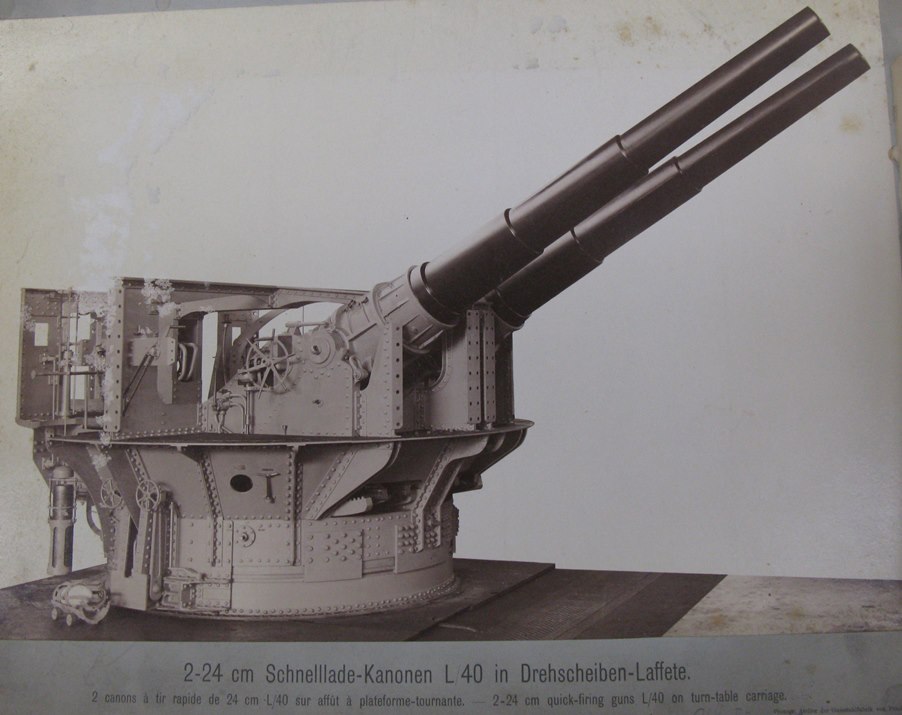
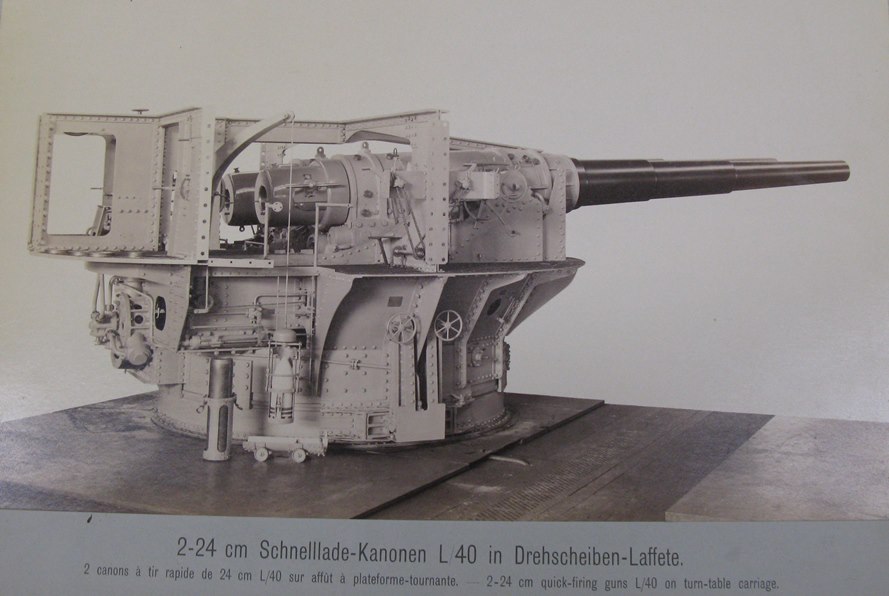

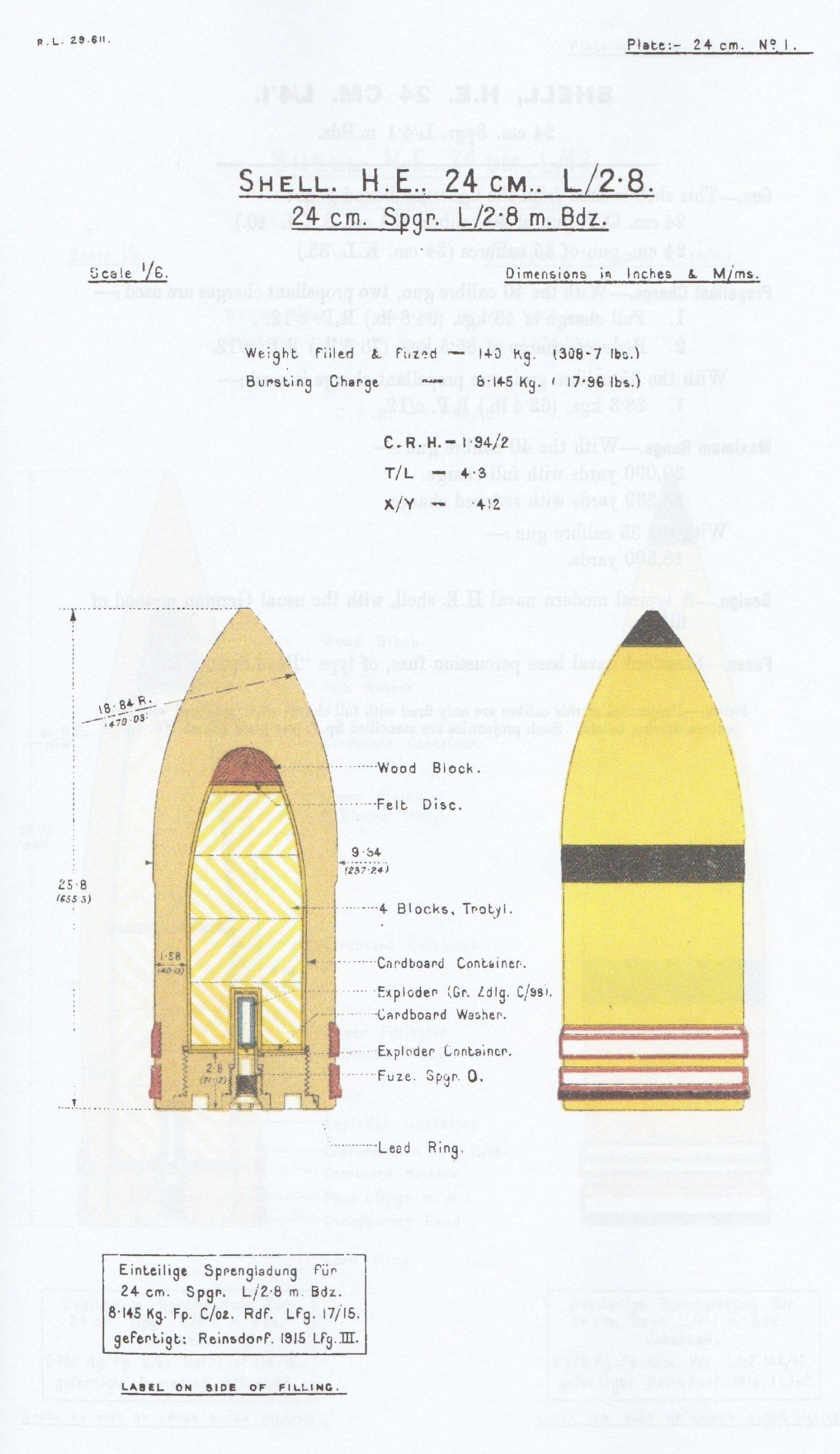
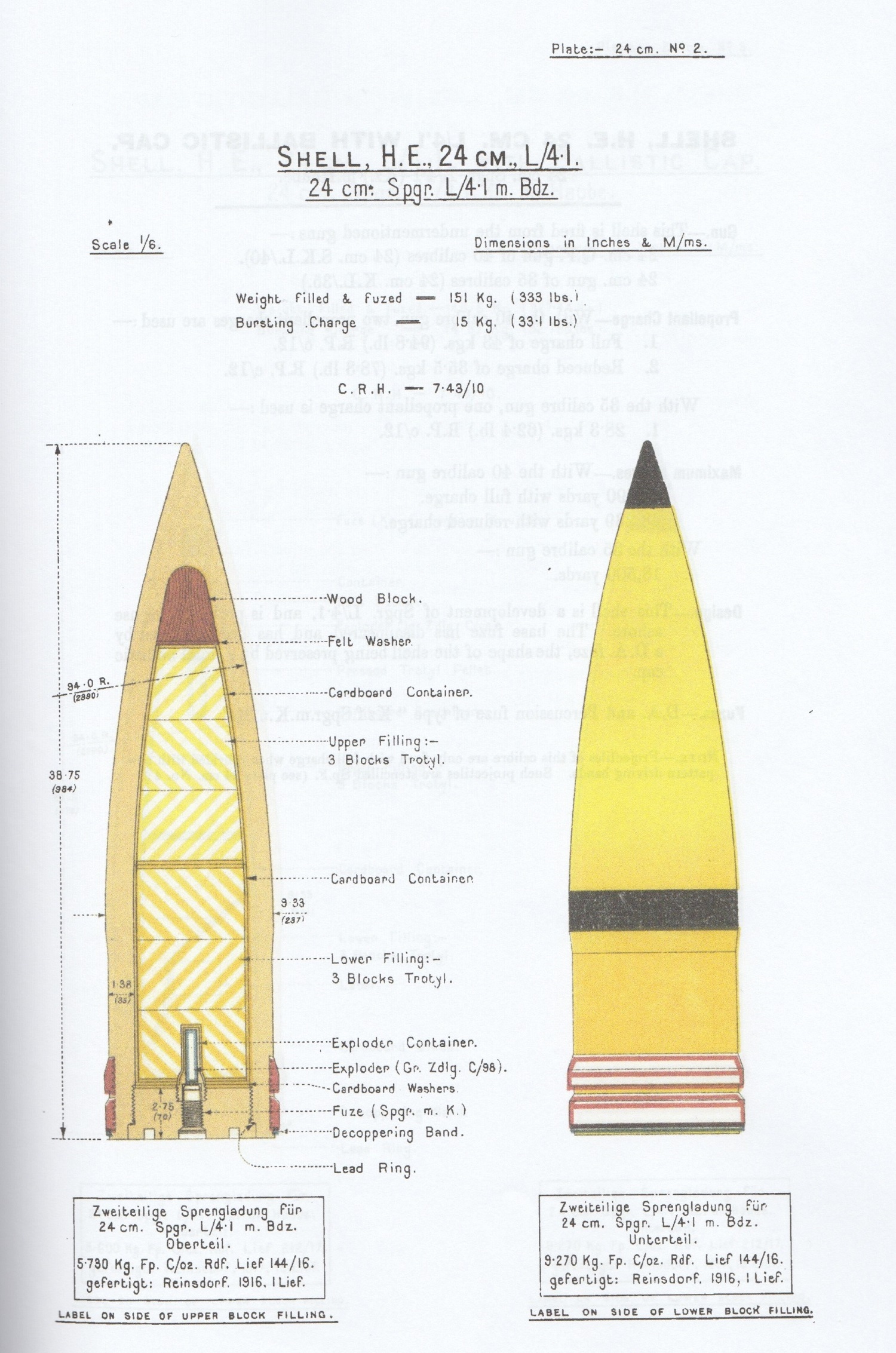
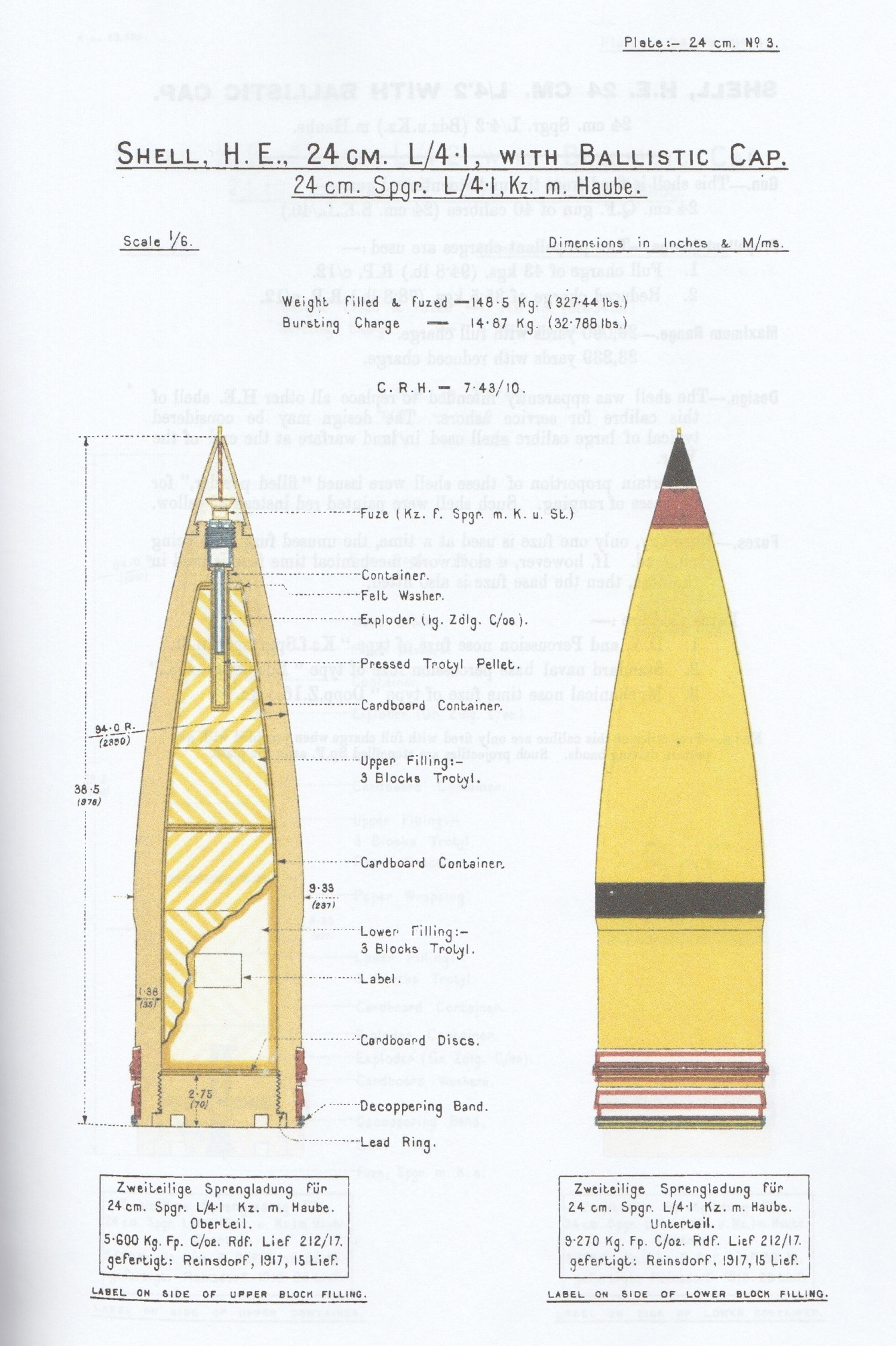
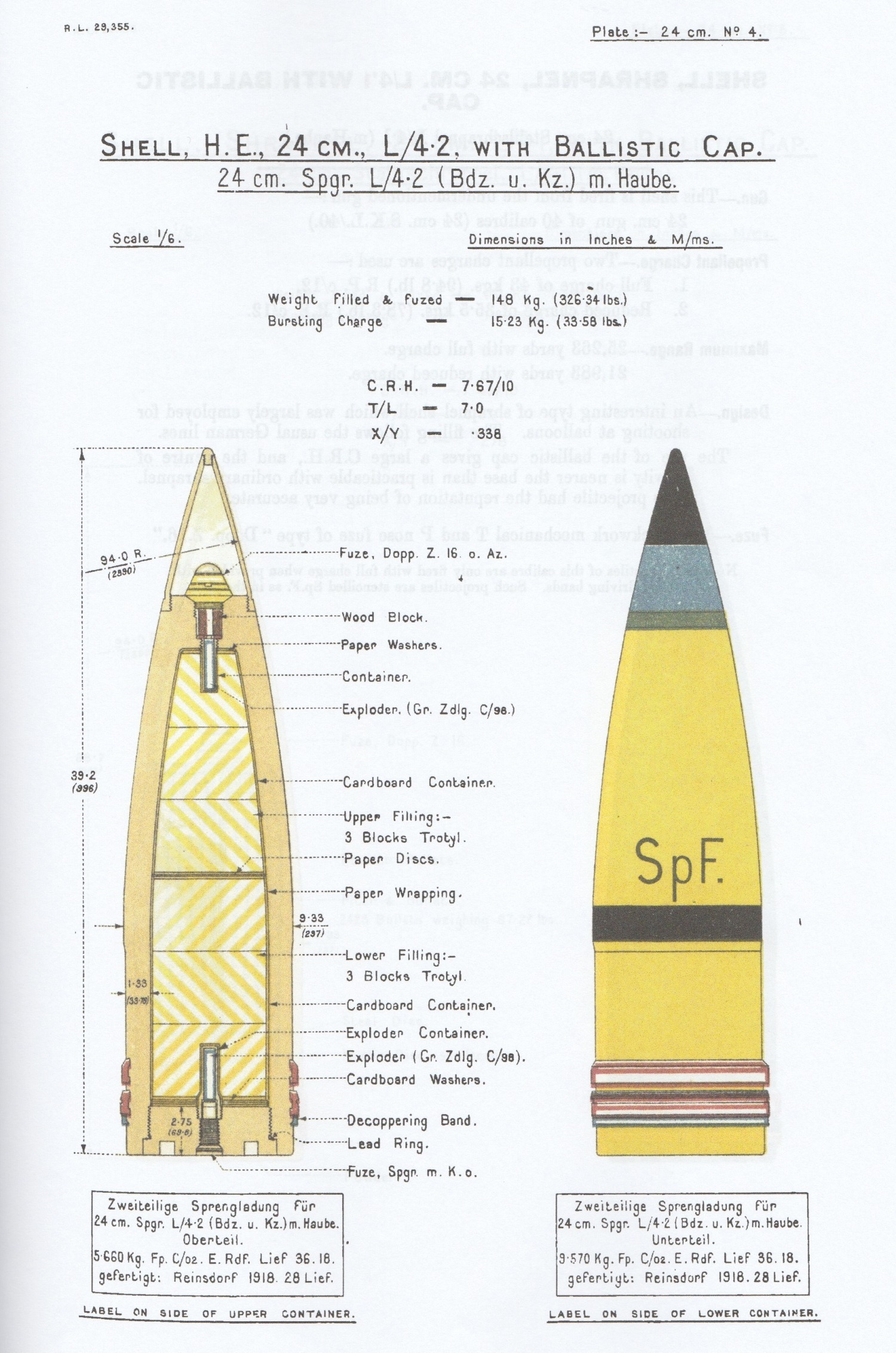

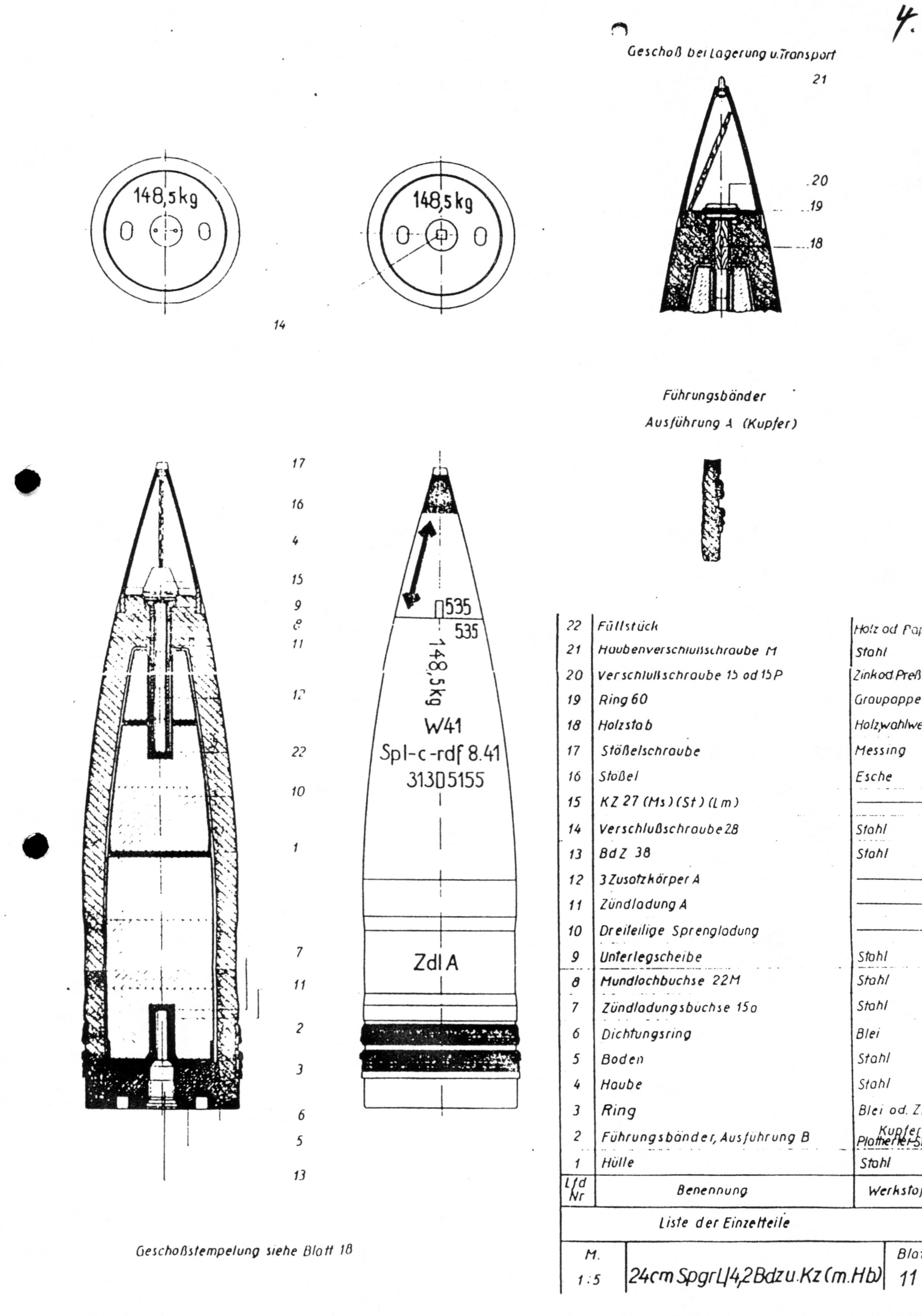
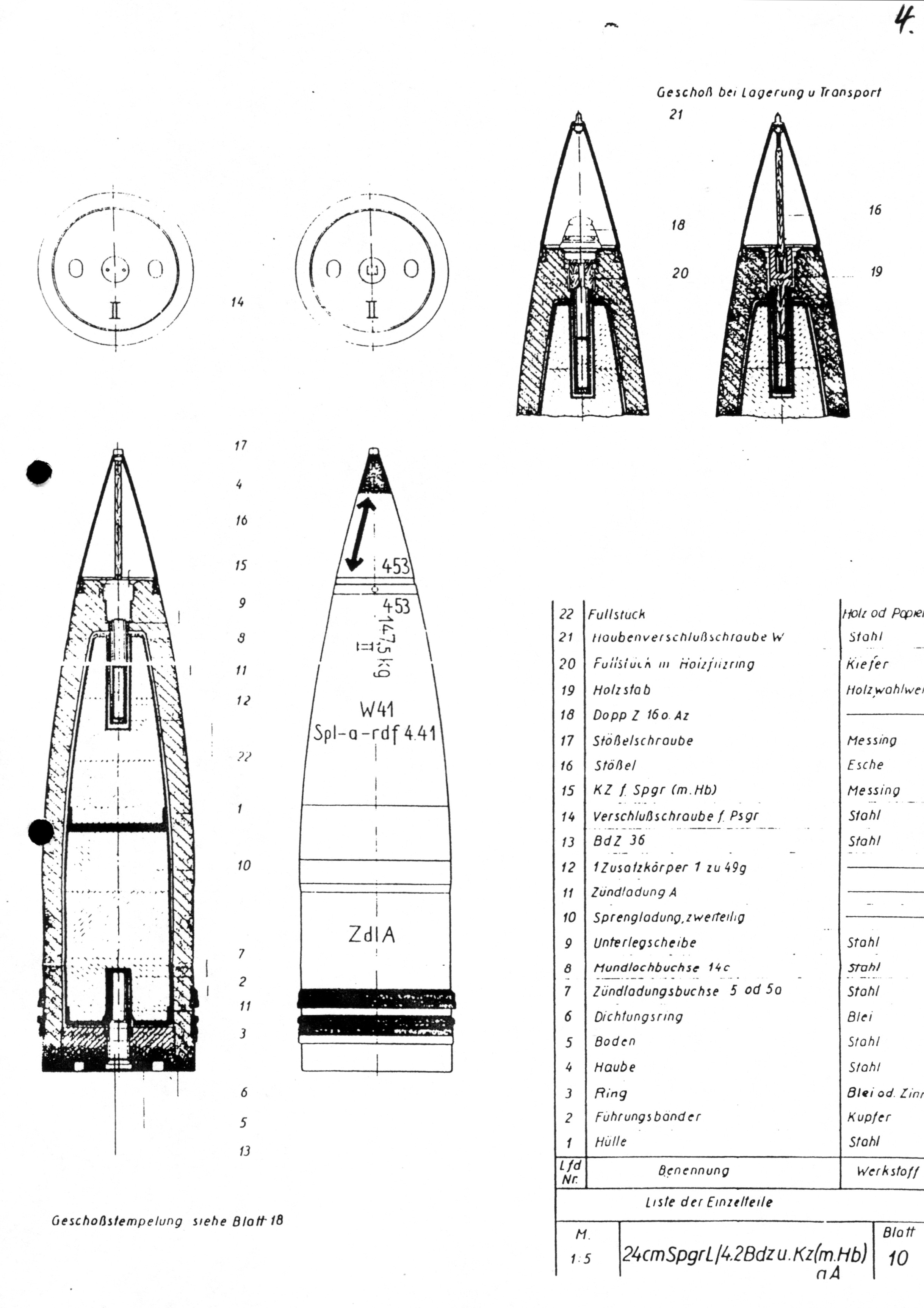

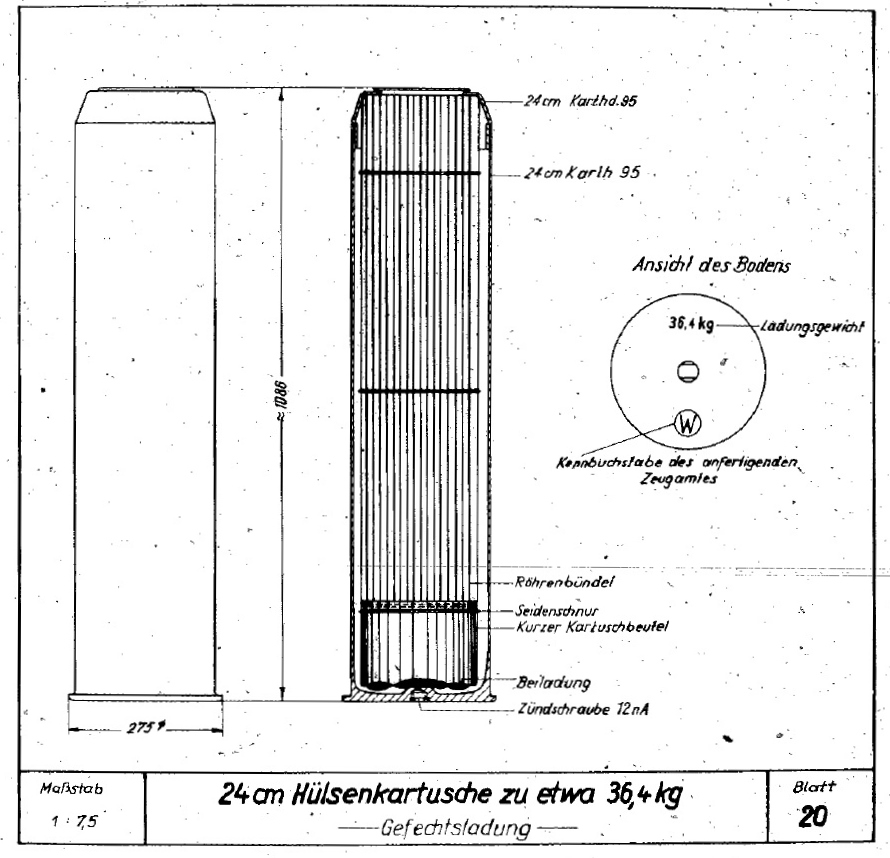
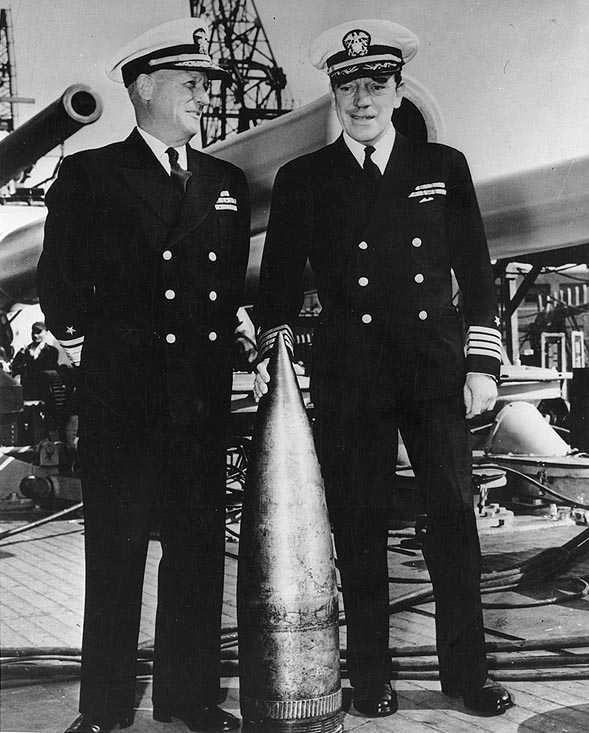
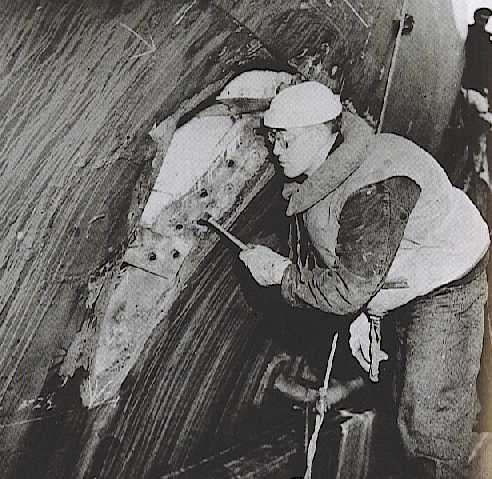
"Naval Weapons of World War Two" by John Campbell
"Naval Weapons of World War One" by Norman Friedman
"German Warships 1815-1945" by Erich Gröner
"German Artillery of World War Two" by Ian Hogg
"Austria-Hungary's Monarch Class Coast Defense Ships" article by Erwin F. Sieche in Warship International No. 3, 1999
"Die Geschichte der deutschen Schiffsartillerie" by Paul Schmalenbach
"Battleships" by Paul Stillwell
---
"Diagrams of Great War - German Naval Guns; Shells & Explosives; Fuses & Exploders" by The Royal Laboratory Woolwich 1921-22
"Munitionsvorschriften für die Kriegsmarine - Panzersprenggranaten (Psgr)" M.Dv. Nr. 190,1A2 by Oberkommando der Kriegsmarine
"Munitionsvorschriften für die Kriegsmarine - Sprenggranaten (Spgr)" M.Dv. Nr. 190,1A3 by Oberkommando der Kriegsmarine
"Munitionsvorschriften für die Kriegsmarine - Hülsenkartusche" M.Dv. Nr. 190,4A1 by Oberkommando der Kriegsmarine
"Munitionsvorschriften für die Kriegsmarine - Vorkartusche" M.Dv. Nr. 190,4A6 by Oberkommando der Kriegsmarine
"Unterricht for das 24 cm Geschútz L/40 K. C/94 [aptiert] S.M.S. Monarch, Wien, Budapest" by Marinesektion, Pola 1900
---
Special help from Peter Lienau, Aleš Maryška, Mihály Krámli and Thorsten Wahl
22 November 2008 - Benchmark
06 April 2009 - Removed mention of Kurfürst Friedrich Wilhelm class, added mention of Škoda guns, added
pictures of Erzherzog Ferdinand Max and Wittelsbach
20 November 2012 - Added details on projectiles and made a separate page for
Austria-Hungary 24 cm guns
24 February 2019 - Converted to HTML 5 format, reorganized notes, added note about ex-Russian guns and added
data and sketches from M.Dv. Nr. 190,1A2, M.Dv. Nr. 190,1A3, M.Dv. Nr. 190,4A1 and M.Dv. Nr. 190,4A6
16 July 2020 - Added Monarch class data and Budapest photographs
14 July 2021 - Fixed formatting problem
14 January 2022 - Added details for "zu etwa" note
25 March 2022 - Added comment about 24 cm shell hit on USS Texas (BB-35)
19 November 2022 - Added information and sketches on World War I coastal artillery projectiles
08 February 2024 - Added weight of Monarch twin turret and additional ammunition data
24 April 2024 - Expanded comment regarding ammunition supply
29 August 2024 - More on the ammunition supply, minor changes for clarity
